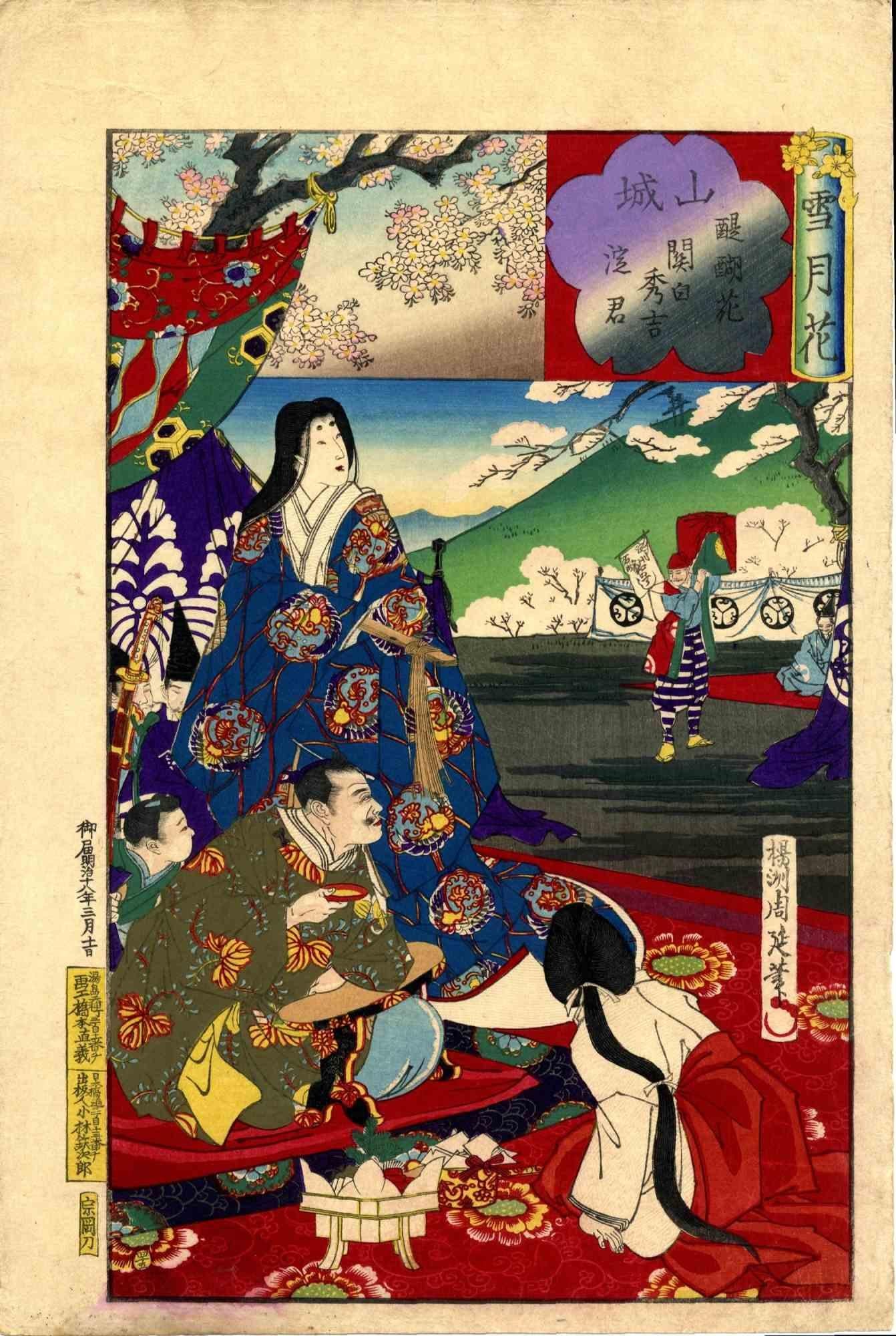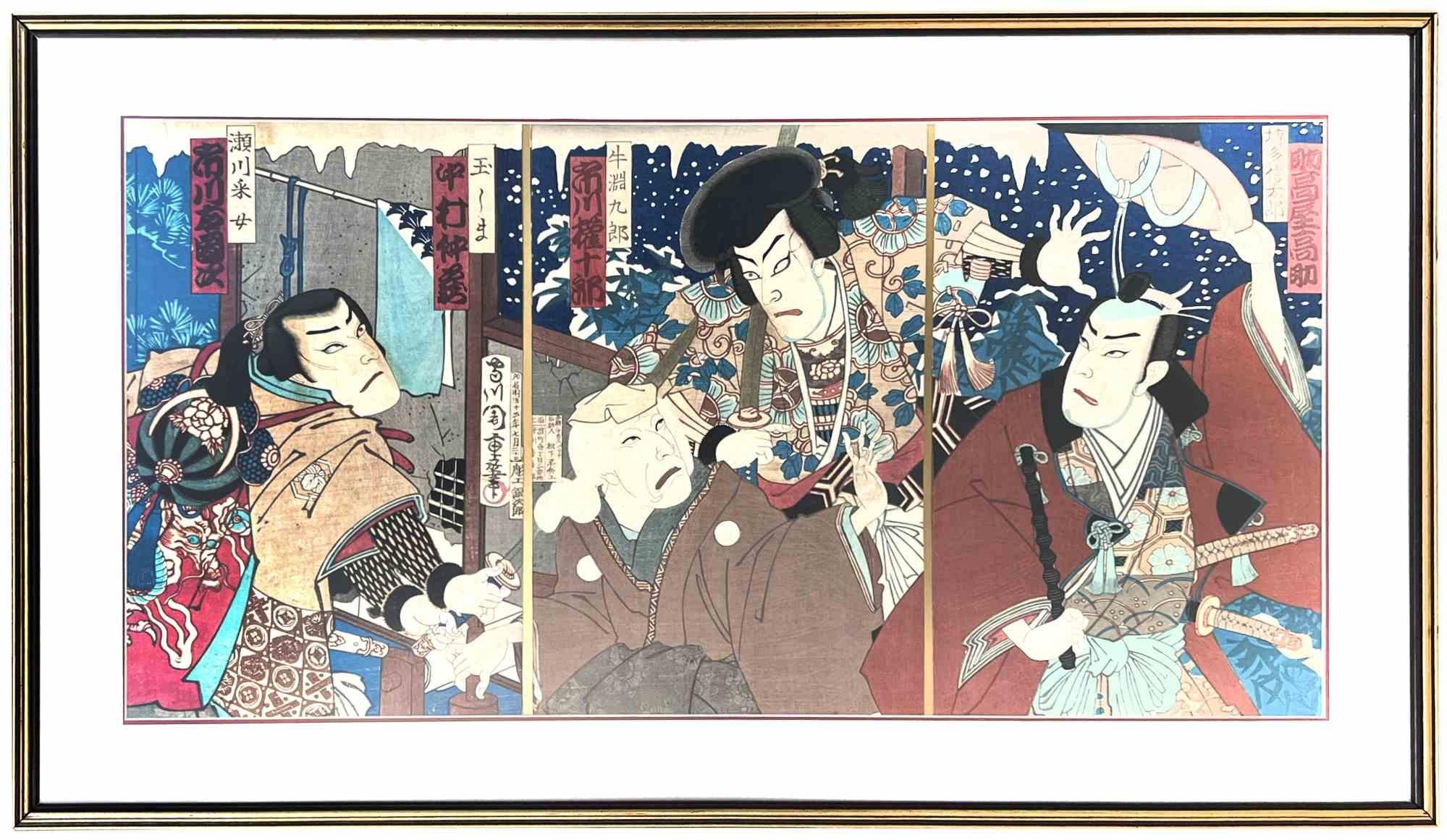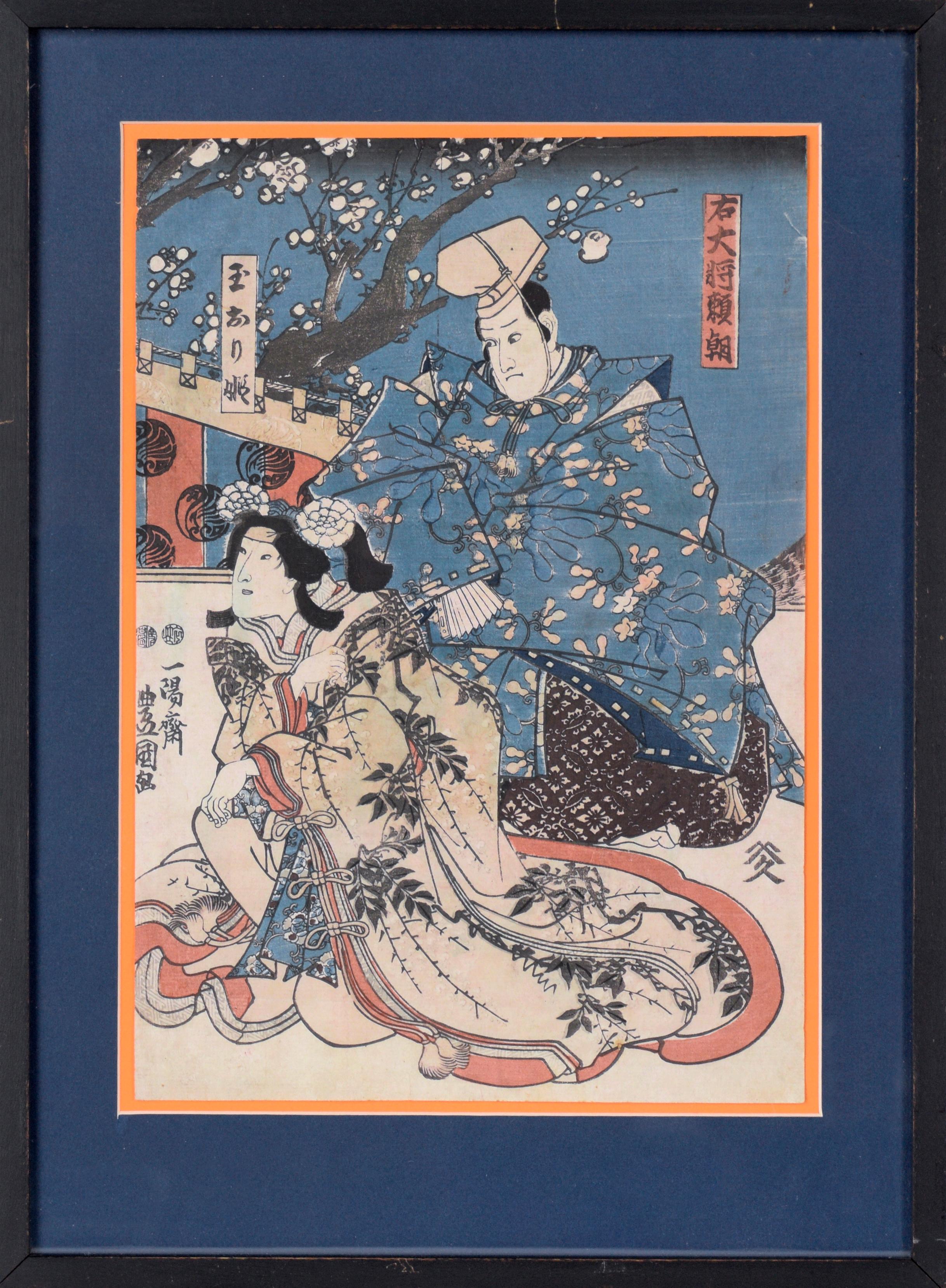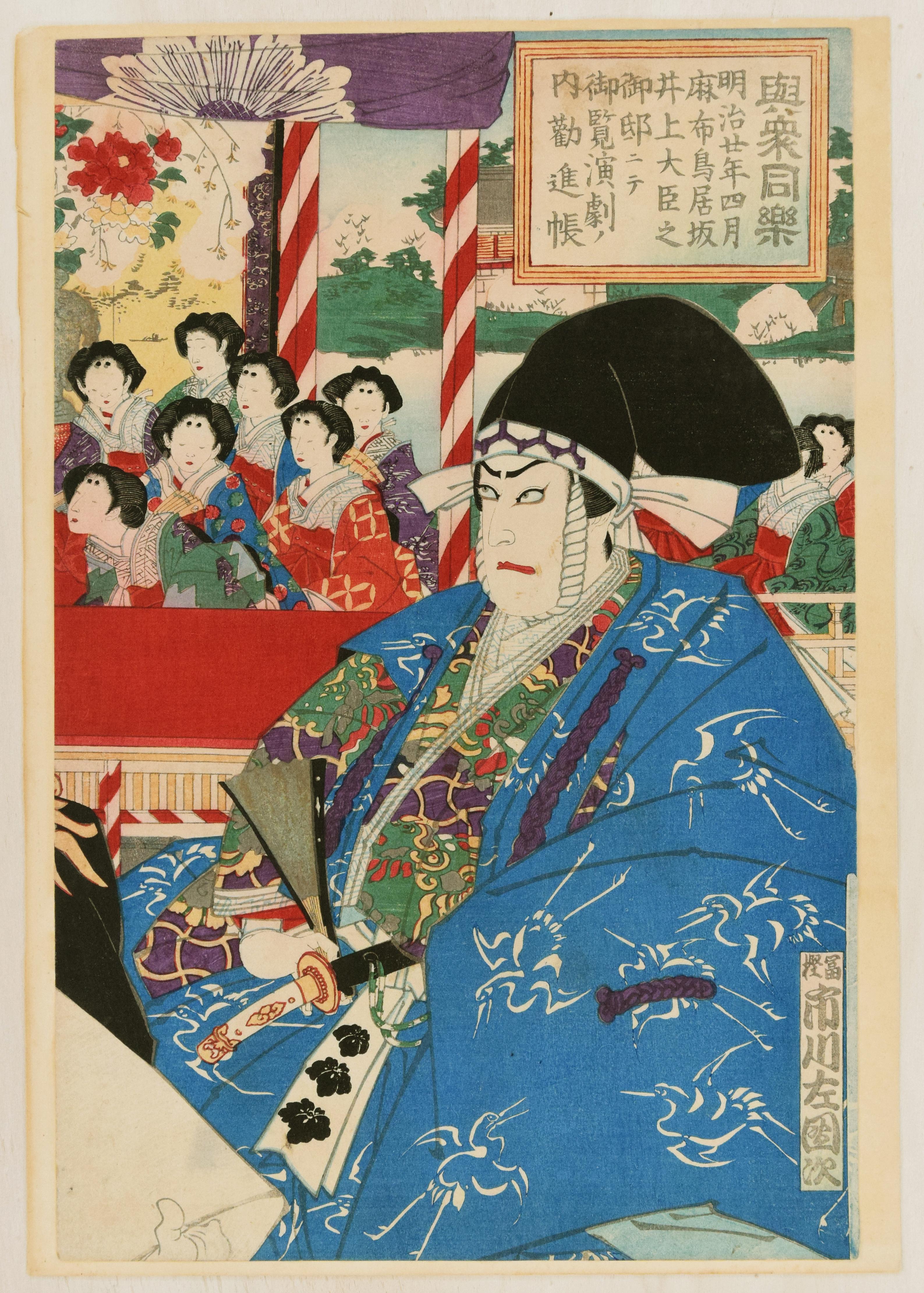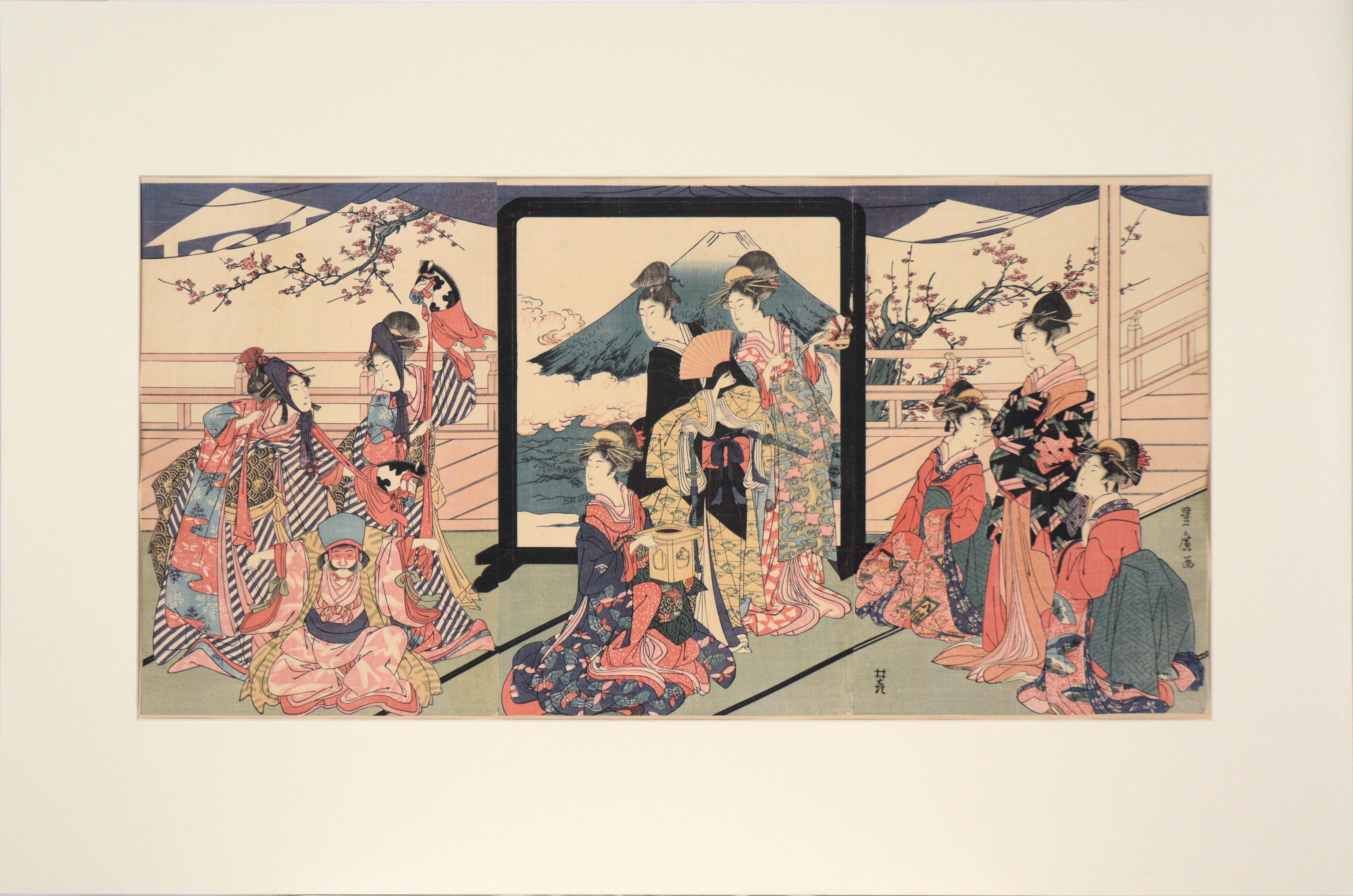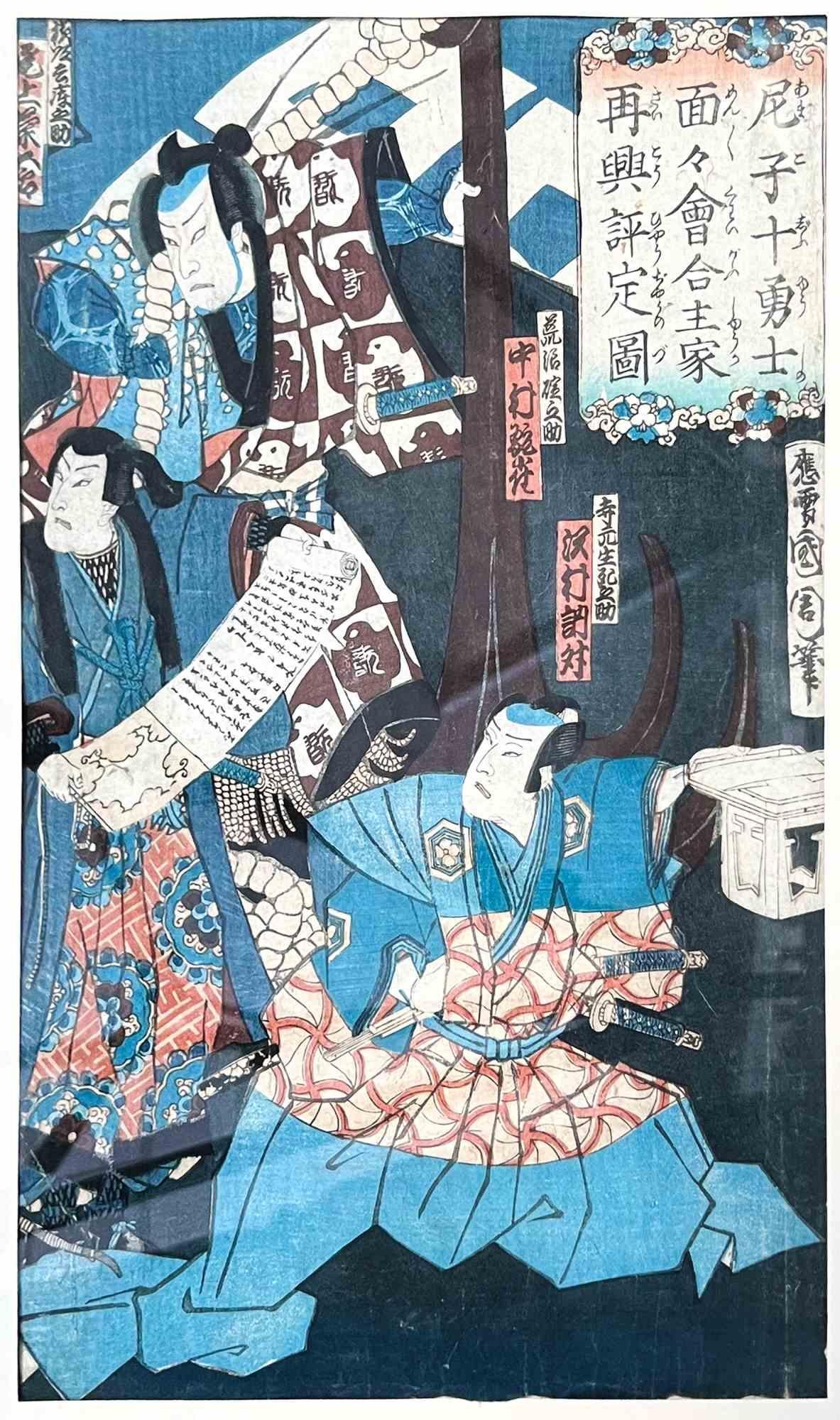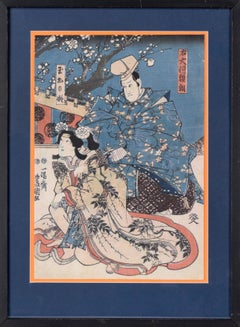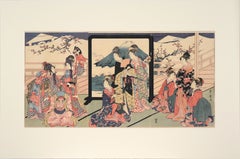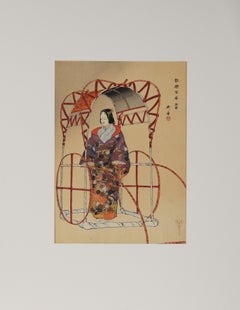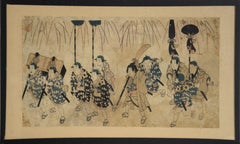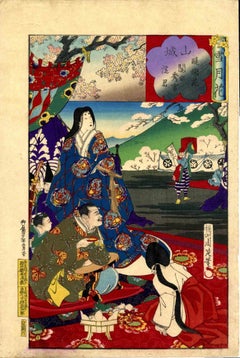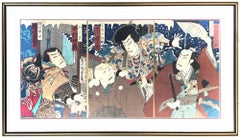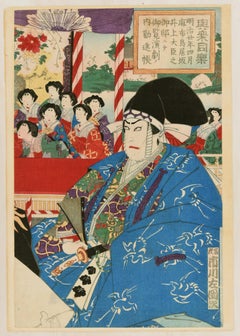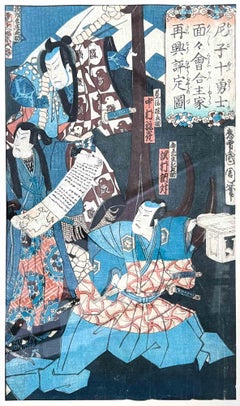Items Similar to "First Horse Day, 1896" - Chiyoda Palace - Japanese Woodblock by Chikanobu Yoshu
Want more images or videos?
Request additional images or videos from the seller
1 of 11
Toyohara Chikanobu"First Horse Day, 1896" - Chiyoda Palace - Japanese Woodblock by Chikanobu Yoshu1896
1896
$700
$87520% Off
£536.38
£670.4720% Off
€616.96
€771.2020% Off
CA$1,000.75
CA$1,250.9320% Off
A$1,086.99
A$1,358.7420% Off
CHF 575.47
CHF 719.3420% Off
MX$13,124.75
MX$16,405.9420% Off
NOK 7,184.17
NOK 8,980.2120% Off
SEK 6,805.86
SEK 8,507.3320% Off
DKK 4,606.78
DKK 5,758.4820% Off
About the Item
"First Horse Day, 1896" - Chiyoda Palace - Japanese Woodblock by Chikanobu Yoshu
Colorful and expressive court scne by Toyohara Chikanobu,"Yoshu" (Japanese, 1838-1912).
This is the rightmost panel from the triptych series, "First Horse Day, 1896", themes from Court Ladies of the Chiyoda Palace, the customs and manners, the lives of court ladies of Tokugawa shogunate in Chiyoda (Edo) palace, and theater performers in various costumes.
Signed "Yōshū Chikanobu" (楊洲周延)
Publisher: Fukuda Hatsujiro
Frame size: 15"H x 10.5"W
Image size: 13.25"H x 9"W
Chikanobu Toyohara (Japanese, 1838-1912) better known to his contemporaries as Yōshū Chikanobu (楊洲周延), was a Japanese painter and printmaker who was widely regarded as a prolific woodblock artist during the Meiji epoch.
In 1875 (Meiji 8), he decided to try to make a living as an artist. He travelled to Tokyo. He found work as an artist for the Kaishin Shimbun. In addition, he produced nishiki-e artworks. In his younger days, he had studied the Kanō school of painting; but his interest was drawn to ukiyo-e. He studied with a disciple of Keisai Eisen and then he joined the school of Ichiyūsai Kuniyoshi; during this period, he called himself Yoshitsuru. After Kuniyoshi’s death, he studied with Kunisada. He also referred to himself as Yōshū.
Like many ukiyo-e artists, Chikanobu turned his attention towards a great variety of subjects. His work ranged from Japanese mythology to depictions of the battlefields of his lifetime to women's fashions. As well as a number of the other artists of this period, he too portrayed kabuki actors in character, and is well known for his impressions of the mie (mise en scène) of kabuki productions. Chikanobu was known as a master of bijinga, images of beautiful women, and for illustrating changes in women's fashion, including both traditional and Western clothing. His work illustrated the changes in coiffures and make-up across time. For example, in Chikanobu's images in Mirror of Ages (1897), the hair styles of the Tenmei era, 1781-1789, are distinguished from those of the Keiō era, 1865-1867. His works capture the transition from the age of the samurai to Meiji modernity, the artistic chaos of the Meiji period exemplifying the concept of "furumekashii/imamekashii".
"The Korean Uprising of 1882" — woodblock print by Chikanobu
Chikanobu is a recognizable Meiji period artist,[8] but his subjects were sometimes drawn from earlier historical eras. For example, one print illustrates an incident during the 1855 Ansei Edo earthquake.[9] The early Meiji period was marked by clashes between disputing samurai forces with differing views about ending Japan's self-imposed isolation and about the changing relationship between the Imperial court and the Tokugawa shogunate.[10] He created a range of impressions and scenes of the Satsuma Rebellion and Saigō Takamori.[11] Some of these prints illustrated the period of domestic unrest and other subjects of topical interest, including prints like the 1882 image of the Imo Incident, also known as the Jingo Incident (壬午事変, jingo jihen) at right.
The greatest number of Chikanobu's war prints (戦争絵, sensō-e) appeared in triptych format. These works documented the First Sino-Japanese War of 1894-1895. For example, the "Victory at Asan"[12] was published with a contemporaneous account of the July 29, 1894 battle.
- Creator:Toyohara Chikanobu (1838 - 1912, Japanese)
- Creation Year:1896
- Dimensions:Height: 15 in (38.1 cm)Width: 10.5 in (26.67 cm)Depth: 0.5 in (1.27 cm)
- Medium:
- Movement & Style:
- Period:
- Condition:Artwork is in fair condition. Color is strong with minor creasing along right edge of paper and some spots of discoloration. Frame and mat included as-is.
- Gallery Location:Soquel, CA
- Reference Number:Seller: ANS90501stDibs: LU54213795822
About the Seller
5.0
Platinum Seller
Premium sellers with a 4.7+ rating and 24-hour response times
Established in 1986
1stDibs seller since 2014
3,014 sales on 1stDibs
Typical response time: <1 hour
- ShippingRetrieving quote...Shipping from: Soquel, CA
- Return Policy
Authenticity Guarantee
In the unlikely event there’s an issue with an item’s authenticity, contact us within 1 year for a full refund. DetailsMoney-Back Guarantee
If your item is not as described, is damaged in transit, or does not arrive, contact us within 7 days for a full refund. Details24-Hour Cancellation
You have a 24-hour grace period in which to reconsider your purchase, with no questions asked.Vetted Professional Sellers
Our world-class sellers must adhere to strict standards for service and quality, maintaining the integrity of our listings.Price-Match Guarantee
If you find that a seller listed the same item for a lower price elsewhere, we’ll match it.Trusted Global Delivery
Our best-in-class carrier network provides specialized shipping options worldwide, including custom delivery.More From This Seller
View AllTwo Actors - Japanese Woodblock by Chikanobu Yoshu
By Toyohara Chikanobu
Located in Soquel, CA
Two Actors - Japanese Woodblock by Toyohara Chikanobu (豊原周延, 1838–1912), better known to his contemporaries as Yōshū Chikanobu (楊洲周延).
Colorful and expressive court scene. Two actors...
Category
1890s Edo Landscape Prints
Materials
Ink, Rice Paper, Woodcut
$700 Sale Price
20% Off
"Toy Horse Dance" Japanese Woodblock Triptych with Beauties and Mt Fuji
Located in Soquel, CA
"Toy Horse Dance" Japanese Woodblock Triptych with Beauties and Mt Fuji
Vibrant three-panel woodblock print by Utagawa Toyohiro (Japanese,...
Category
Early 20th Century Edo Figurative Prints
Materials
Ink, Rice Paper, Woodcut
"Pictures Of Noh" - 1922 Original Japanese Woodblock Print
Located in Soquel, CA
"Pictures Of Noh" - 1922 Original Japanese Woodblock Print
Original Japanese woodblock print by Tsukioka Kogyo (Japanese, 1869-1927...
Category
1920s Edo Figurative Prints
Materials
Ink, Rice Paper, Woodcut
Festival Procession Of A Daimyo - Original Woodblock Print
Located in Soquel, CA
Procession Of A Daimyo - Original Woodblock Print
Original woodblock print depicting the procession of a Daimyo. Ten Japanese soldiers are seen as they aid in transporting the Daimy...
Category
Late 18th Century Edo Figurative Prints
Materials
Ink, Wood Panel, Rice Paper
$720 Sale Price
20% Off
Elegant Amusements of Eastern Genji - Japanese Triptych Woodblock Print on Paper
By Utagawa Kunisada (Toyokuni III)
Located in Soquel, CA
Elegant Amusements of Eastern Genji - Japanese Triptych Woodblock Print on Paper
Dynamic woodblock print with several elegantly dressed figures by Utag...
Category
1850s Edo Figurative Prints
Materials
Paper, Ink, Woodcut
Annual Events for Young Murasaki (July) - Tales of Genji - Japanese Woodblock
By Utagawa Kunisada (Toyokuni III)
Located in Soquel, CA
Annual Events for Young Murasaki (July) - Tales of Genji - Japanese Woodblock
Rightmost panel a triptych, depicting monthly events for Wakamurasaki (Young Murasaki). This is the month of July. There appears to be a lesson taking place, possibly for writing or poetry.
Artist: Toyokuni III/Kunisada (1786 - 1864)
Publisher: Ebisu-ya Shoshichist
Presented in a new blue mat.
Mat size: 19"H x 13"W
Paper size: 14.5"H x 10"W
Commentary on the triptych:
In the Edo period, Tanabata was designated as one of the five seasonal festivals, and became an annual event for the imperial court, aristocrats, and samurai families, and gradually came to be celebrated by the general public. Its origins are said to be a combination of the Kikoden festival, which originated from the Chinese legend of Altair and the Weaver Girl, and Japan's ancient Tanabata women's faith. Ink is ground with dew that has accumulated on potato leaves, poems and wishes are written on five colored strips of paper, which are then hung on bamboo branches to celebrate the two stars that meet once a year. Although the illustration is a Genji painting...
Category
1850s Realist Figurative Prints
Materials
Printer's Ink, Rice Paper, Woodcut
You May Also Like
The Flowering Daigo - Woodcut by Toyohara Chikanobu - 1885
By Toyohara Chikanobu
Located in Roma, IT
The Flowering Daigo is an original artwork realized in 1885 by Toyohara Chikanobu (1838–1912).
Limited edition woodcut print signed on plate.
From the series "Setsu gekka", (Snow, ...
Category
1880s Modern Figurative Prints
Materials
Woodcut
Kabuki Scene- Woodcut by Toyohara Kunichika - The Late 19th Century
By Toyohara Kunichika
Located in Roma, IT
Kabuki Scene is a Japanese multi-colored woodcut tryptich realized around the end of the 19th century by Toyohara Kunichika (1835 - 1900).
Original woodcut on paper. The artwork is ...
Category
19th Century Modern Figurative Prints
Materials
Woodcut
Kabuki Scene from "Kanjincho" - Woodcut by 1887 ca.
By Kunichika Toyohara
Located in Roma, IT
A scene from the important representation of Tenno Kabuki's Play "Kanjincho", held during the Meiji Era in the House of Minister Kaoru Inoue at the presence of the Emperor Akinori Aki and of the Princess Akira Terada. Attributed to the Ukiyo-e Master Kinichika Toyohara (Oshima Yasohachi), specialised in the representations of Kabuki Scenes on Woodcut blocks...
Category
1820s Figurative Prints
Materials
Woodcut
$1,457 Sale Price
35% Off
Kabuki Scene - Woodcut by Toyohara Kunichika - Late 19th Century
By Toyohara Kunichika
Located in Roma, IT
Kabuki Scene: Teramoto Life, Death Nosuke, Sawamura Bansho is a wooduct print realized by Kunichika Toyohara (1835-1900) in the late 19th Century.
In very good condition, includes ...
Category
19th Century Modern Figurative Prints
Materials
Woodcut
Parade - Woodblock Print by Utagawa Kunisada - Mid-19th Century
By Utagawa Kunisada (Toyokuni III)
Located in Roma, IT
Celebratory Parade is an original Woodcut print realized in mid 19th century after Utagawa Kunisada.
Good condition and Beautiful colored woodblock print.
This wonderful modern a...
Category
Mid-19th Century Modern Figurative Prints
Materials
Woodcut
Yugiri - Woodcut by Utagawa Kunisada - 1850s
By Utagawa Kunisada (Toyokuni III)
Located in Roma, IT
Yugiri is an original artwork realized in the 1850s by Utagawa Kunisada (1786-1865).
Chapter 39 of the story Genji Monogatari. Color woodcut around 1851. Signed: Ichiyossai Toyokun...
Category
1850s Modern Figurative Prints
Materials
Woodcut
More Ways To Browse
Antique Earthquake
Horse Japanese
Antique Korean Prints
Korean Woodblock
Gilot Signed
Henri de Toulouse-Lautrec On Sale
Henri Matisse Danseuse
Henry De Groux
Hogarth Etching
Iwo Jima
Jacques Jacob
Jean De Paleologue
Jim Dine Dorian
John Buckland Wright
Journal Des Demoiselles
Kathe Kollwitz Etchings
Kees van Dongen On Sale
Keith Haring Eye
